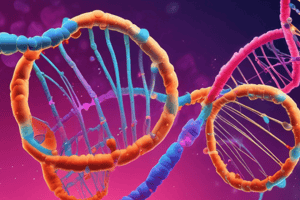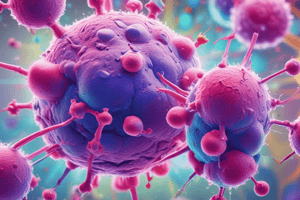Podcast
Questions and Answers
What are the two phases of growth discussed in animals?
What are the two phases of growth discussed in animals?
- Embryonic and Juvenile (correct)
- Fetal and Embryonic
- Adult and Zygotic
- Juvenile and Adult
Where does cell proliferation continue in animals during the juvenile phase?
Where does cell proliferation continue in animals during the juvenile phase?
- In the heart tissues
- In the growth plates of bones (correct)
- In the skin layers
- In the brain regions
What is the primary region for cell proliferation in plants?
What is the primary region for cell proliferation in plants?
- Vascular bundles
- Xylem tissue
- Meristems (correct)
- Phloem regions
What changes occur to daughter cells formed by division at the apical meristem?
What changes occur to daughter cells formed by division at the apical meristem?
What is the role of the root apical meristem?
What is the role of the root apical meristem?
During which phase of life is there a rapid increase in height due to cell division in bones?
During which phase of life is there a rapid increase in height due to cell division in bones?
What happens to cells that form the margin of the meristem?
What happens to cells that form the margin of the meristem?
Which of the following is NOT a characteristic of apical meristems?
Which of the following is NOT a characteristic of apical meristems?
What typically happens to a haploid cell that lacks essential chromosome 21?
What typically happens to a haploid cell that lacks essential chromosome 21?
What is the consequence of having an extra chromosome in a haploid cell?
What is the consequence of having an extra chromosome in a haploid cell?
What role do shoot apical meristems play in plant growth?
What role do shoot apical meristems play in plant growth?
What happens to cells as they travel towards the skin surface in the epidermis?
What happens to cells as they travel towards the skin surface in the epidermis?
In which scenario might an extra chromosome not be lethal?
In which scenario might an extra chromosome not be lethal?
What occurs during the fusion of gametes in relation to chromosome 21?
What occurs during the fusion of gametes in relation to chromosome 21?
Why is cell replacement in the epidermis considered debatable regarding cell proliferation?
Why is cell replacement in the epidermis considered debatable regarding cell proliferation?
What role do genes coding for essential polypeptides play in haploid cells?
What role do genes coding for essential polypeptides play in haploid cells?
What is essential for tissue repair after a wound occurs in plant roots?
What is essential for tissue repair after a wound occurs in plant roots?
How is non-disjunction related to chromosome 21 and haploid cells?
How is non-disjunction related to chromosome 21 and haploid cells?
How does friction affect the cells in the epidermis over time?
How does friction affect the cells in the epidermis over time?
What characteristic of keratin affects epidermal cells?
What characteristic of keratin affects epidermal cells?
What is the expected outcome of an embryo with three copies of chromosome 21?
What is the expected outcome of an embryo with three copies of chromosome 21?
What happens to haploid cells that cannot properly undergo meiotic division?
What happens to haploid cells that cannot properly undergo meiotic division?
Which process accompanies cell proliferation in the epidermis?
Which process accompanies cell proliferation in the epidermis?
In what scenario might the ability of tissues to heal vary?
In what scenario might the ability of tissues to heal vary?
What is the role of cohesin loops during mitosis?
What is the role of cohesin loops during mitosis?
Which phase follows the replication of DNA in the cell cycle?
Which phase follows the replication of DNA in the cell cycle?
What happens to cells produced by mitosis and cytokinesis when they enter G0 phase?
What happens to cells produced by mitosis and cytokinesis when they enter G0 phase?
How many DNA molecules are present in a chromosome during G2 phase?
How many DNA molecules are present in a chromosome during G2 phase?
In which stage of the cell cycle do cells enter Gap zero (G0)?
In which stage of the cell cycle do cells enter Gap zero (G0)?
What is the primary reason for cells to leave the cell cycle and enter G0?
What is the primary reason for cells to leave the cell cycle and enter G0?
During which stage is the amount of DNA measured in cells from different cultures?
During which stage is the amount of DNA measured in cells from different cultures?
What is likely to be true about the DNA content in human egg and sperm cells?
What is likely to be true about the DNA content in human egg and sperm cells?
Where are ribosomes assembled in a cell?
Where are ribosomes assembled in a cell?
What characterizes interphase in most cells?
What characterizes interphase in most cells?
What is the role of cyclins in the cell cycle?
What is the role of cyclins in the cell cycle?
What happens if cyclins do not reach a threshold concentration?
What happens if cyclins do not reach a threshold concentration?
Which cyclin is responsible for preparing the cell for DNA replication?
Which cyclin is responsible for preparing the cell for DNA replication?
What is one function of Cyclin B during the cell cycle?
What is one function of Cyclin B during the cell cycle?
What is the primary purpose of checkpoints in the cell cycle?
What is the primary purpose of checkpoints in the cell cycle?
During which phase does Cyclin D trigger the cell to enter DNA synthesis (S phase)?
During which phase does Cyclin D trigger the cell to enter DNA synthesis (S phase)?
What characterizes malignant tumours?
What characterizes malignant tumours?
Which tissues are more likely to produce malignant tumours?
Which tissues are more likely to produce malignant tumours?
How would you describe the variable rate of cell division in tumours?
How would you describe the variable rate of cell division in tumours?
What is the mitotic index?
What is the mitotic index?
What are the steps to calculate the mitotic index from a micrograph?
What are the steps to calculate the mitotic index from a micrograph?
What imaging method is used to check for the spread of cancer?
What imaging method is used to check for the spread of cancer?
What is commonly known as cancer?
What is commonly known as cancer?
Why is a diagnosis of cancer always concerning for patients?
Why is a diagnosis of cancer always concerning for patients?
Flashcards
Non-disjunction
Non-disjunction
The failure of chromosomes to separate properly during cell division, resulting in daughter cells with an abnormal number of chromosomes.
Haploid cell
Haploid cell
A cell with only one set of chromosomes. It results from meiosis.
Diploid zygote
Diploid zygote
A zygote formed from the fusion of two gametes. It has two sets of chromosomes.
Trisomy
Trisomy
Signup and view all the flashcards
Meiosis
Meiosis
Signup and view all the flashcards
Monosomy
Monosomy
Signup and view all the flashcards
Genes coding for essential polypeptides
Genes coding for essential polypeptides
Signup and view all the flashcards
Normal cell
Normal cell
Signup and view all the flashcards
Growth
Growth
Signup and view all the flashcards
Juvenile phase
Juvenile phase
Signup and view all the flashcards
Apical meristem
Apical meristem
Signup and view all the flashcards
Cell proliferation
Cell proliferation
Signup and view all the flashcards
Cell differentiation
Cell differentiation
Signup and view all the flashcards
Cells formed at the margin of an apical meristem
Cells formed at the margin of an apical meristem
Signup and view all the flashcards
Region of an apical meristem
Region of an apical meristem
Signup and view all the flashcards
Plant growth
Plant growth
Signup and view all the flashcards
Shoot Apical Meristem
Shoot Apical Meristem
Signup and view all the flashcards
Stem Cells
Stem Cells
Signup and view all the flashcards
Tissue Repair
Tissue Repair
Signup and view all the flashcards
Cell Replacement
Cell Replacement
Signup and view all the flashcards
Basal Layer of the Epidermis
Basal Layer of the Epidermis
Signup and view all the flashcards
Keratin
Keratin
Signup and view all the flashcards
Differentiation
Differentiation
Signup and view all the flashcards
S Phase
S Phase
Signup and view all the flashcards
G1 Phase
G1 Phase
Signup and view all the flashcards
G2 Phase
G2 Phase
Signup and view all the flashcards
G0 Phase
G0 Phase
Signup and view all the flashcards
Cohesin Loops
Cohesin Loops
Signup and view all the flashcards
DNA Replication
DNA Replication
Signup and view all the flashcards
DNA Content
DNA Content
Signup and view all the flashcards
Cyclins
Cyclins
Signup and view all the flashcards
Cyclin-dependent kinases (CDKs)
Cyclin-dependent kinases (CDKs)
Signup and view all the flashcards
Cell Cycle Checkpoints
Cell Cycle Checkpoints
Signup and view all the flashcards
Cell Cycle
Cell Cycle
Signup and view all the flashcards
Cyclin Types
Cyclin Types
Signup and view all the flashcards
Metastasis
Metastasis
Signup and view all the flashcards
Mitotic Index
Mitotic Index
Signup and view all the flashcards
Meristematic Region
Meristematic Region
Signup and view all the flashcards
Hormonal Stimulation of Cell Division
Hormonal Stimulation of Cell Division
Signup and view all the flashcards
Cancer
Cancer
Signup and view all the flashcards
Malignant Tumors
Malignant Tumors
Signup and view all the flashcards
Study Notes
Cell Cycle
- The cell cycle is a repeating sequence of processes
- Mitosis involves dividing the nucleus
- Cytokinesis involves dividing the entire cell
Mitosis Stages
- Prophase: Nucleus membrane disperses. Chromatids condense.
- Metaphase: Chromosomes line up in the center of the cell.
- Anaphase: Chromatids separate and move to opposite poles.
- Telophase: Nuclear membranes reform. Chromosomes uncoil.
Meiosis
- A type of cell division that produces haploid cells
- Two rounds of division (meiosis I and meiosis II)
- Meiosis I: Homologous chromosomes separate
- Meiosis II: Sister chromatids separate
Meiosis and Variation
- Crossing over: Exchange of genetic material between homologous chromosomes
- Random orientation: Random alignment of homologous chromosomes
- These processes create genetic variation in offspring
Cell Proliferation
- Rapid increase in cell numbers
- Essential for growth, cell replacement, and tissue repair
- Cell division rates must be faster than cell death rates
Cell Cycle Checkpoints
- Critical control points that regulate progression through the cell cycle
- Ensure proper DNA replication and cell division
Mutations and Tumors
- Proto-oncogenes: Involved in cell growth and division; mutations can cause them to become oncogenes (promote excessive cell division)
- Tumor suppressor genes: Involved in preventing uncontrolled cell division; mutations can affect the function of these genes, causing them to lose their ability to inhibit growth
- Mutations in genes that control the cell cycle can lead to uncontrolled cell growth and formation of tumors.
- Mutagens increase the chance of mutations. Some chemicals and types of radiation are mutagens.
Studying That Suits You
Use AI to generate personalized quizzes and flashcards to suit your learning preferences.




